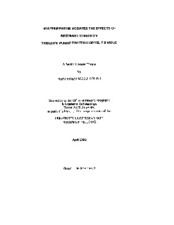| dc.creator | McCullough, Heath Keay | |
| dc.date.accessioned | 2013-02-22T20:40:26Z | |
| dc.date.available | 2013-02-22T20:40:26Z | |
| dc.date.created | 2002 | |
| dc.date.issued | 2013-02-22 | |
| dc.identifier.uri | https://hdl.handle.net/1969.1/ETD-TAMU-2002-Fellows-Thesis-M3831 | |
| dc.description | Due to the character of the original source materials and the nature of batch digitization, quality control issues may be present in this document. Please report any quality issues you encounter to digital@library.tamu.edu, referencing the URI of the item. | en |
| dc.description | Includes bibliographical references (leaves 13-15). | en |
| dc.description.abstract | Theiler's Murine Encephalomyelitis Virus (TMEV) is an important model of multiple sclerosis (MS) (Lipton, 1975). Theiler's virus induces a biphasic disease that, in the chronic phase, causes a remitting relapsing demyelination of the central nervous system (CNS) similar to that of MS. Chronic restraint stress in the acute/early phase profoundly affects vulnerability to TMEV. When an animal is subjected to a stressor, several biological pathways are activated. Previous studies conducted in our lab have investigated the role of the hypothalamic pituitary adrenal (HPA) axis and the glucocorticoid corticosterone. The sympathetic nervous system (SNS) is also activated by stress and initiates the release of the catecholamine norepinephrine (NE) from the adrenal medulla. Norepinephrine is believed to have immunosuppressive effects. Here, we attempt to determine if NE is mediating the deleterious effects restraint stress on TMEV. To examine this issue, seventy-one 24-day old male CBA mice were surgically implanted with either a pellet of the β₂-adrenergic antagonist nadolol, or a pellet containing only vehicle on three days prior to infection. The mice were then restrained for 12 hours overnight, and infected intracranially with 5 X10⁴ PFU of the BeAn strain of TMEV on day 0 post infection. For the following 4 weeks, restraint was administered 5 nights a week for 12 hours per session. The effects of stress on TMEV were measured daily using two scales, one to measure the relative sickness of the animal and the second to measure the degree of hind limb weakness and paralysis. The body weight of the animals was also recorded daily. This study confirms that norepinephrine is indeed a mediator of the stress response. Animals receiving the placebo had higher mortality, more severe clinical symptoms, and greater hind limb weakness and paralysis than animals receiving the norepinephrine antagonist nadolol. | en |
| dc.format.medium | electronic | en |
| dc.format.mimetype | application/pdf | |
| dc.language.iso | en_US | |
| dc.publisher | Texas A&M University | |
| dc.rights | This thesis was part of a retrospective digitization project authorized by the Texas A&M University Libraries in 2008. Copyright remains vested with the author(s). It is the user's responsibility to secure permission from the copyright holder(s) for re-use of the work beyond the provision of Fair Use. | en |
| dc.subject | life sciences II. | en |
| dc.subject | Major life sciences II. | en |
| dc.title | Norepinephrine mediates the effects of restraint stress on Theiler's Murine Encephalomyelitis Virus | en |
| thesis.degree.department | life sciences II | en |
| thesis.degree.discipline | life sciences II | en |
| thesis.degree.name | Fellows Thesis | en |
| thesis.degree.level | Undergraduate | en |
| dc.type.genre | thesis | en |
| dc.type.material | text | en |
| dc.format.digitalOrigin | reformatted digital | en |


